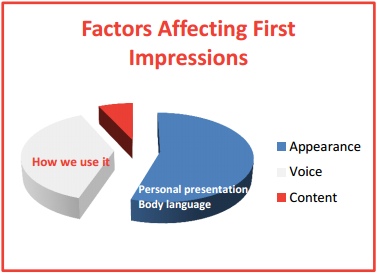This is a guest post by Joanna Gaudoin. She is a business coach who focuses on image and personal brand building. We're happy to gain her insights, so we're excited about sharing them with you.
You will know the importance of first impressions. The arguments about just how many seconds it takes to form a first impression of someone are many, but it is certainly less than 10! Think about people you meet for the first time, not just in a professional setting but a social one too. Is it not true that you make some sort of assessment about them the minute you clap eyes on them? It will be subconscious and fleeting but goes on to affect how you respond to and interact with that person.
What you may not know is that only 7% of what we actually say is responsible for what that first impression is. Furthermore, a staggering 55% is due to visual cues - our appearance in terms of what we are wearing, how well groomed we are and what we are communicating with our body language. That leaves the remaining 38% to our voice including tone, pitch, volume and pace. *Data according to Mehrabian

Therefore, whilst all 4 factors are important for a face-to-face meeting, the relative importance of them changes when we are 'meeting' someone remotely. Clearly the relative importance of our voice will increase, however does it mean the visual has no role to play? I would argue this is not the case and would like to share some tips with you for making a positive impression when you are not being seen (neither in person nor via online e.g. Skype) and for reinforcing that impression to create a credible image that continues past the first impression.
You might think it doesn't matter what you wear if nobody can see you. However, often how we feel is affected by what we wear. Of course, this does depend on the sector you work in, the role you have and your personality. I am not suggesting you need to put your most formal suit on for working remotely but it is worth bothering - having a shower and dressing in a way that makes you feel 'at work', especially if you are making calls and sending emails. How we feel can be communicated strongly through our voice.
If someone hasn't met you, your written communication is also likely to play a stronger role in creating a perception of what you are like for the other person. Think carefully about the words you use in emails, how you set them out and your attention to detail.
Body language - our posture and how we sit also affect how we feel which will in turn affect our voice, similar to our appearance. For professional phone calls, I would always recommend sitting or standing up straight, despite the temptation to slouch in an armchair. It helps you stay focused and ensures your voice is clear and well-articulated.
Lastly voice, the element that surely becomes the most important factor in a remote scenario. Like our words on a page, our voice says so much about us in the absence of the visual. So what matters?
- Tone - think very carefully about this as it could easily be taken out of context without body language and expressions. If you want to communicate slight frustration/annoyance that may be appropriate, just be aware that you are doing so.
- Pitch – men generally have a lower pitch than women. It is sensible to make sure your voice is not too high pitched as this can appear overly feminine and less credible. This is particularly important in a male dominated environment.
- Volume - a louder voice often communicates authority and sometimes excitement. Whilst you don't want to deafen the other person or appear to be shouting, a quiet, timid voice will have a negative impact on your credibility.
- Pace is important as it communicates emotion. Faster pace tends to represent anger, enthusiasm or nervousness - depending on the tone and pitch that accompanies it. Not that you want to talk very slowly but a moderately paced way of speaking is usually the best way to convey yourself credibly.
I am certainly someone that prefers meeting face to face, at least initially; it means you learn about someone quicker as there are more cues. This is not always possible in today's professional, global landscape. However, making the right impression and building a credible, professional image are still vitally important for our personal career success and that of our organisation.








